Increasing voluntary feed intake of the sow is a major challenge for nutritionists in tropical climate conditions. Recently we published a study (Silva et al., 2018) aiming to determine if the adverse effects of heat stress on lactating sows could be overcome by using a flavour added to the diet to stimulate feed intake and improve sow and litter performance in a tropical humid climate. Our findings indicated that even when sows are kept under heat stress conditions, there is still a threshold for increasing the feed intake probably provided by the thermal amplitude, when during the cooler periods (i.e. evening and early morning) sows could compensate low diurnal feed intake if properly stimulated.
The addition of feed flavour compounds may increase voluntary feed consumption and help alleviate lactation demands (Frederick and Van Heugten, 2006; Silva et al., 2018). In our study, sows fed the feed flavour showed a higher feed intake than the control sows (i.e. up to +24% on average for feeds containing flavour). More recently we investigated the impact of supplementing sows during lactation with the same feed flavour on their feeding behavior and kinetics of daily feed intake under tropical conditions using an Automated Intelligent Feeder (AIF). During the ad libitum period (between 1 and 23 days post-farrowing), a total of 7,132 daily measurements of feeding behaviour variables were made on 60 sows. In this study, daily feed intake during lactation (d 1 to 23) was affected by season, where the feed intake was less during the hot season than in the cool season (5.66 vs. 7.23 kg/d; Figure 1). The daily ingestion time was less in the hot than in the cool season (36.8 vs. 72.3 min/d, respectively) and the ingestion time per meal was also lower in the hot compared to the cool season (5.7 vs. 7.5 min/meal, respectively).

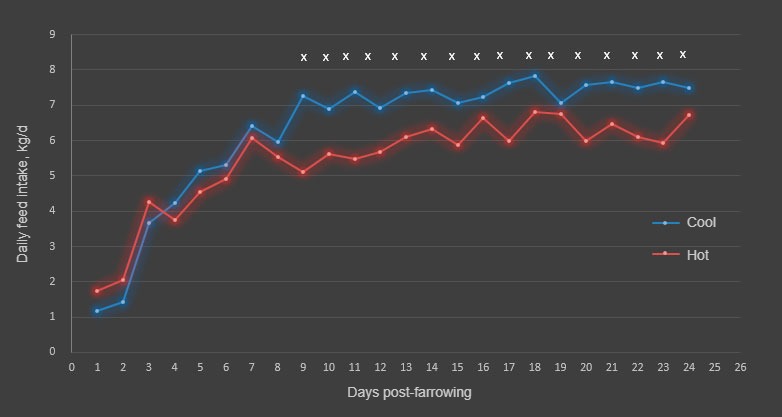
Figure 1. Daily feed intake during cool and hot season. Feed intake differed between seasons from d 9 to 18 and from d 20 to 24 (×; P<0.05). A total of 17 and 31 sows were used for cool and hot, respectively.
Irrespective of the season, the nycthemeral pattern of feed intake peaked twice daily. The first and second peaks were observed between 00:00 a.m. and 10:00 a.m. and between 15:00 a.m. and 20:00 a.m., respectively (Figure 2).
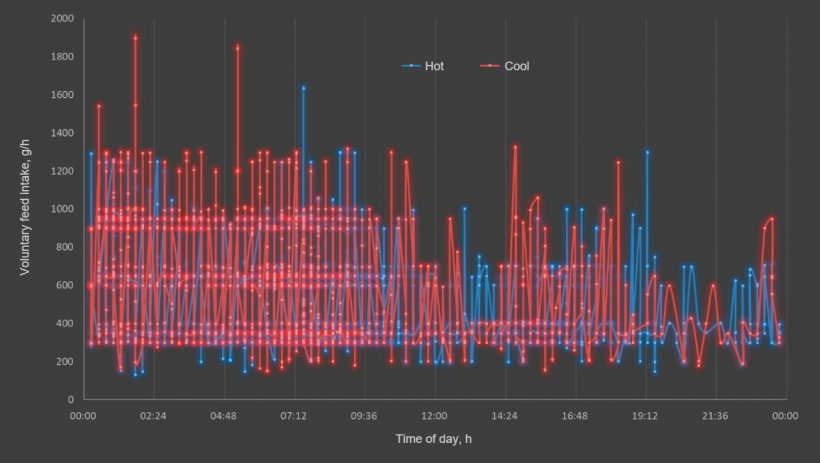
Figure 2. Effect of season and time of day on the daily feed intake in lactating sows (solid lines). Each point is an input of 18 sows in the cool season and 32 sows in the hot season.
The average meal size was 107 g/meal lower in sows fed the control diet when compared with flavour fed sows. Daily feed intake was greater in the flavour diet than in the control (6,417 vs. 5,362 g/d). Sows receiving flavour showed a higher nocturnal (704 vs. 583 g/meal) and diurnal (678 vs. 582 g/meal) feed intake when compared to control fed sows. Irrespective of treatment, the sows also showed a higher voluntary intake between 00:00 and 10:00 a.m., which was equivalent to 83% of the total daily feed intake. From a comparison of hourly feed intakes or variations from hour to hour (during 24 h), the nycthemeral pattern of feed intake peaked twice daily for both dietary treatments. However, the size of the peak differed, and the hourly feed intakes were greater for flavour fed sows when compared with the control at 04:00 a.m. and 05:00 a.m. (Figure 3). Diets also influenced the kinetics of daily feed intake during the lactation period. Feed intake was higher for flavour from d 3 to weaning (Figure 4).
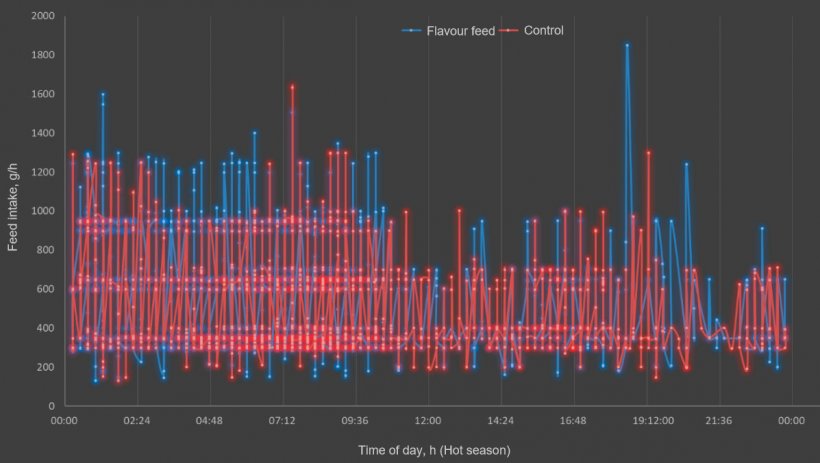
Figure 3. Effect of feed flavour and time of day on the daily feed intake in lactating sows during hot season.
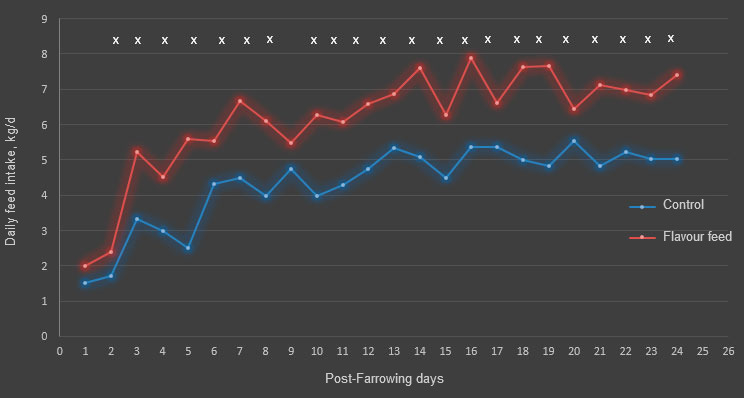
Figure 4. Daily feed intake during Hot season. Feed intake differed between diets from d 2 to d 8 and from d 9 to d 24 (×; P<0.05).
In pigs, the peripheral senses, especially smell, taste, and oral somatosensing (oronasal sensing) interpret stimuli important to feed quality and nutritional value (Dulac, 2000; Forbes, 1998; Roura et al., 2008a,b). The sense of smell seems to be the most developed of all the senses in pigs (Morrow-Tesch and McGlone, 1990). Pigs exhibit an olfactory system with extremely high sensitivity compared to other animals (Roura and Tedó, 2009). The taste system is defined as the oral chemosensory system that recognises a diverse repertoire of non-volatile compounds. Not less than five different tastes have been defined and are widely accepted: sweet, umami, salty, sour, and bitter (Roura and Tedó, 2009).
According to Jones et al. (2000), five odourised foods which are categorized by humans as sweet (i.e. almond oil, peach, raspberry, vanilla, and strawberry) have a good acceptance by pigs. This positive effect of feed flavors can be beneficial for the modern prolific sow that, although bred to be very productive, often exhibits a reduced feed intake capacity as a result of the genetic selection for higher feed efficiency (Bergsma et al., 2009).
Final Considerations and Implications
Our findings confirm that in tropical conditions, climatic factors, specifically high temperatures and RH, limit the performance and voluntary feed intake of lactating sows. Moreover, the results suggest that lactating sows tend to keep a similar feeding behaviour during both seasons, with a more pronounced intake between 00:00 and 09:00 a.m. Sows may not change feeding pattern according to season, but significantly reduce their total feed intake under hot climate conditions in order to reduce the thermal effect of feed. In addition, it seems that even when sows are kept under heat stress conditions, there is still a threshold within the thermal amplitude for increasing feed intake and improving feeding patterns, when during the cooler periods (i.e. evening and early morning) sows could compensate low diurnal feed intake if properly stimulated. Our findings lead us to believe that the strategic use of a feed flavour to manipulate the sensorial properties of feed is a viable strategy to increase the sows’ voluntary feed intake and benefit milk production and consequently improve litter performance, all of which can help attenuate the negative effects of heat stress conditions on the nursing sow.
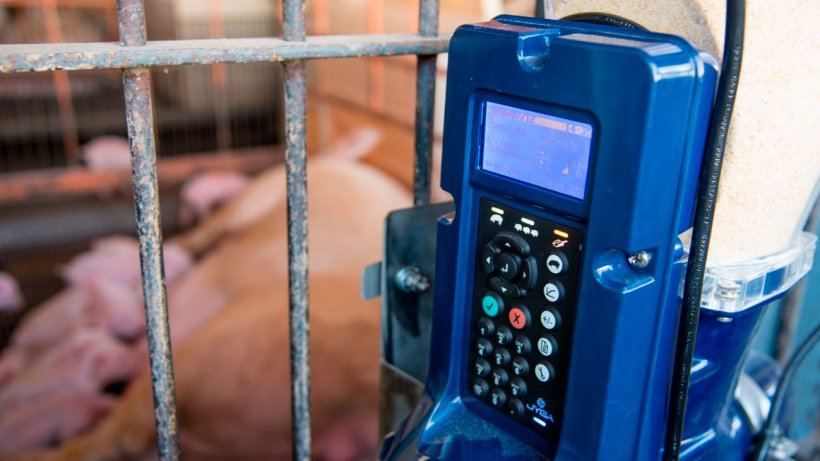
Farrowing Facilities UFMG/ ICA – photo by Amanda Le



